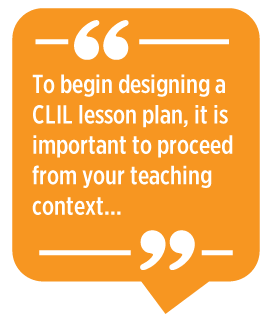|
 Since the content and language integrated learning
approach (CLIL) was introduced in language/subject teaching in the 1990s (Ball
et al., 2015), CLIL learning materials have been in high demand. CLIL is the
teaching of content through an additional language, which means students learn
both content and language simultaneously. Various ways to address the demand
for CLIL materials have been in use: Since the content and language integrated learning
approach (CLIL) was introduced in language/subject teaching in the 1990s (Ball
et al., 2015), CLIL learning materials have been in high demand. CLIL is the
teaching of content through an additional language, which means students learn
both content and language simultaneously. Various ways to address the demand
for CLIL materials have been in use:
-
subject-based books written in the target language from
their country of origin,
- translating subject-based books from a country’s
national curriculum into the target language,
- developing and publishing CLIL course books made
for each specific country’s national curriculum, and
- teachers making their own CLIL materials tailored
to their specific teaching context (national curriculum, course syllabus,
students’ needs).
(Ball et al., 2015)
This article is concerned with educators who wish
to create their own CLIL materials to address their specific students’ learning
needs. To be considered high quality for CLIL purposes, such materials should
follow certain criteria regarding their structure and content.
Creating High-Quality CLIL Materials
Various CLIL researchers have created checklists
that outline the important characteristics of high-quality CLIL materials.
Following are a few of those characteristics.
According to Mehisto (2012), high-quality CLIL
materials
- make the learning objectives and
process clear and meaningful to students.
- systematically develop academic language
proficiency, critical thinking, cognitive fluency, learner autonomy, and
learning skills.
- include cooperative learning activities, authentic
language, and authentic language use.
- include self-, peer, and other types of formative
assessment.
- scaffold content, language, and learning skills
development.
- help students progress faster than they would on
their own.
Ball et al. (2015) suggest that it is important
- to build learning around specific tasks
(i.e., the text is subservient to the task), which should address three
dimensions of content (concept, procedure, language) and make key language
visible.
- that students’ understanding of input and
production of output should be supported with scaffolding (i.e., explicit
language support) and embedding (i.e., systematic inclusion of key language in
activities for students to pick it up naturally).
- that learning activities are logically sequenced
and integrated (e.g., before , during, and after activities; orientation,
complication, and resolution activities).
- that the materials are of appropriate difficulty,
which is achieved by manipulating the three dimensions of content to make the
topic accessible to students.
Developing a CLIL Lesson Plan
With these materials design fundamentals in mind,
in this article we suggest a 5-step procedure for developing a CLIL lesson plan
with embedded learning materials. Coyle et al. (2010) recommend using the 4Cs
(content, communication, cognition, and culture) framework in CLIL lesson planning
and materials design, which means that learning outcomes and activities of a
CLIL lesson should target the development of students’ subject knowledge,
language skills, cognitive abilities, and intercultural awareness.
 Step 1: Define the Language Level and
Subject Area/Topic Step 1: Define the Language Level and
Subject Area/Topic
To begin the designing of a CLIL lesson plan, it is
important to proceed from your teaching context, which includes the
national/school curriculum, the level of the target language, students’ grade, subject
areas, and topics to be covered. For example, in our educational context in
Estonia, we can take Natural Science as one of the subject areas listed in the
Estonian National Curriculum for Basic Schools (see the English version here)
and Habitats as one of the suggested topics, with Temperate Forests as a
specific lesson topic. The lesson will target primary schoolers, with Common
European Framework of Reference for Languages (CEFR) Level A2 English
language proficiency.
Step 2: Choose the
Input
Now, select appropriate authentic input (i.e.,
content meant for native speakers of that language and not adapted for language
learners) on the chosen topic. The input can be textual, audio-visual, or
multimodal. (It can be, e.g., an infographic, encyclopedia entry,
newspaper/magazine article, radio/TV program, podcast, and/or video clip).
Evaluate the chosen authentic input in terms of its
age and level appropriacy. In our example, for the topic of Temperate Forest
Habitat, we can take a text titled “Temperate Forest Habitat” with multimodal
input from the National
Geographic Kids website.
Step 3: Write 4Cs Learning Outcomes
for the Lesson
CLIL lessons should cover four areas of learning to
enable students to reach learning outcomes: communication, content, cognition,
and culture.
➢ Communicative learning
outcomes might focus on grammar and vocabulary (e.g., comparison of
adjectives, new words/terms) and language subskills (e.g., skimming and
scanning a text, expressing opinion, agreeing and disagreeing).
➢ Content learning
outcomes entail the development of subject knowledge (e.g., facts,
data, terms, concepts, processes, procedures, formulas).
➢ Cognitive learning
outcomes should target the development of students’ thinking skills
(e.g., using Bloom’s Taxonomy).
➢ Culture learning
outcomes focus on the development of cultural knowledge,
intercultural competence, and global citizenship.
For example, we might suggest the following 4Cs
learning outcomes for our lesson on temperate forest habitats:
➢ Communication:
Students name different types of trees and animals in temperate
forests.
➢ Content: Students
describe the habitat of temperate forests.
➢ Cognition:
Students create a set of criteria to define a temperate forest
habitat.
➢ Culture: Students
determine whether their surrounding environment includes a temperate forest
habitat and in which other countries it can be found.
Step 4: Adapt the Text for Your
Target Group to Make It Learner Friendly
Utilize various text adaptation techniques to make
it learner friendly, including simplifying the language, excluding difficult
vocabulary, reducing the amount of text, and breaking the text down into
shorter pieces. Add headings, subtitles, visuals, and graphic organizers of
various types (e.g., dot point lists, tables, charts, mind maps, graphics) to
make authentic content more learner appropriate. In our example lesson, we
would add pictures of trees and animals, create a glossary, include a video
about temperate forests and its inhabitants, highlight key ideas in the text,
and so on.
Step 5: Devise Lesson Activities
The final step is to devise activating (lead-in),
input processing, output, and assessment activities that will help achieve the
learning outcomes of the lesson. It is important to write simple and clear
instructions (rubrics) before each activity and add the answers to each
activity (answer keys) at the end of the lesson (in teacher’s notes).
The activities should also be arranged and
formatted appropriately and attractively on the page to increase learner
engagement and interest by using various design tools and visuals. The Appendix
gives a selection of activities to use for different stages of the CLIL lesson,
which teachers can choose from to design their own lesson.
Conclusion
Many practicing teachers consider materials design
to be a time-consuming and challenging process. And yet, with the increasing
need of CLIL learning materials for particular learning contexts, CLIL teachers
can write their own learner-tailored materials—rather than wait for and rely on
publishers and expert teams in CLIL materials design. Hopefully, the suggested
5-step procedure will serve you in this creative process.
References
Ball, P., Kelly, K., & Clegg, J. (2015). Putting CLIL into practice. Oxford University
Press.
Coyle, D., Hood, P., & Marsh, D. (2010). CLIL: Content and language integrated learning. Cambridge
University Press.
Mehisto, P. (2012). Criteria for producing CLIL
learning material. Encuentro, 21, 15–33.
https://files.eric.ed.gov/fulltext/ED539729.pdf
Nina
Raud, PhD, is lecturer in English at Narva
College of the University of Tartu, Estonia. Her research interests include teaching English
in multicultural and multilingual classes, CLIL and ELT methodology, English
language teacher training and professional development, materials design, and
active learning.
Olga
Orehhova, MA, is junior lecturer in English
at Narva College of the University of Tartu, Estonia. Her research interests
include English language teaching and learning, EFL teacher training, CLIL and
ELT methodology, and materials and course design. |